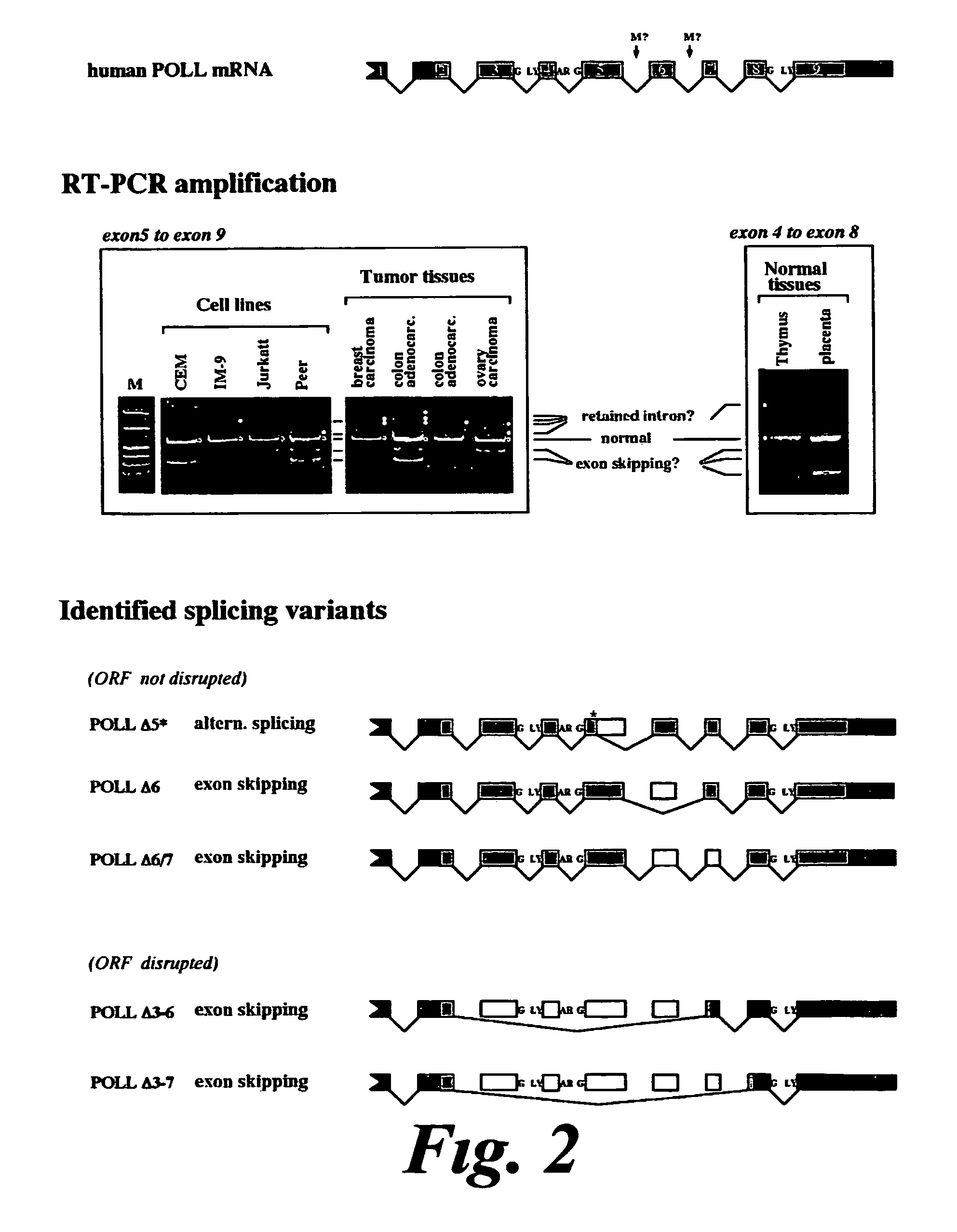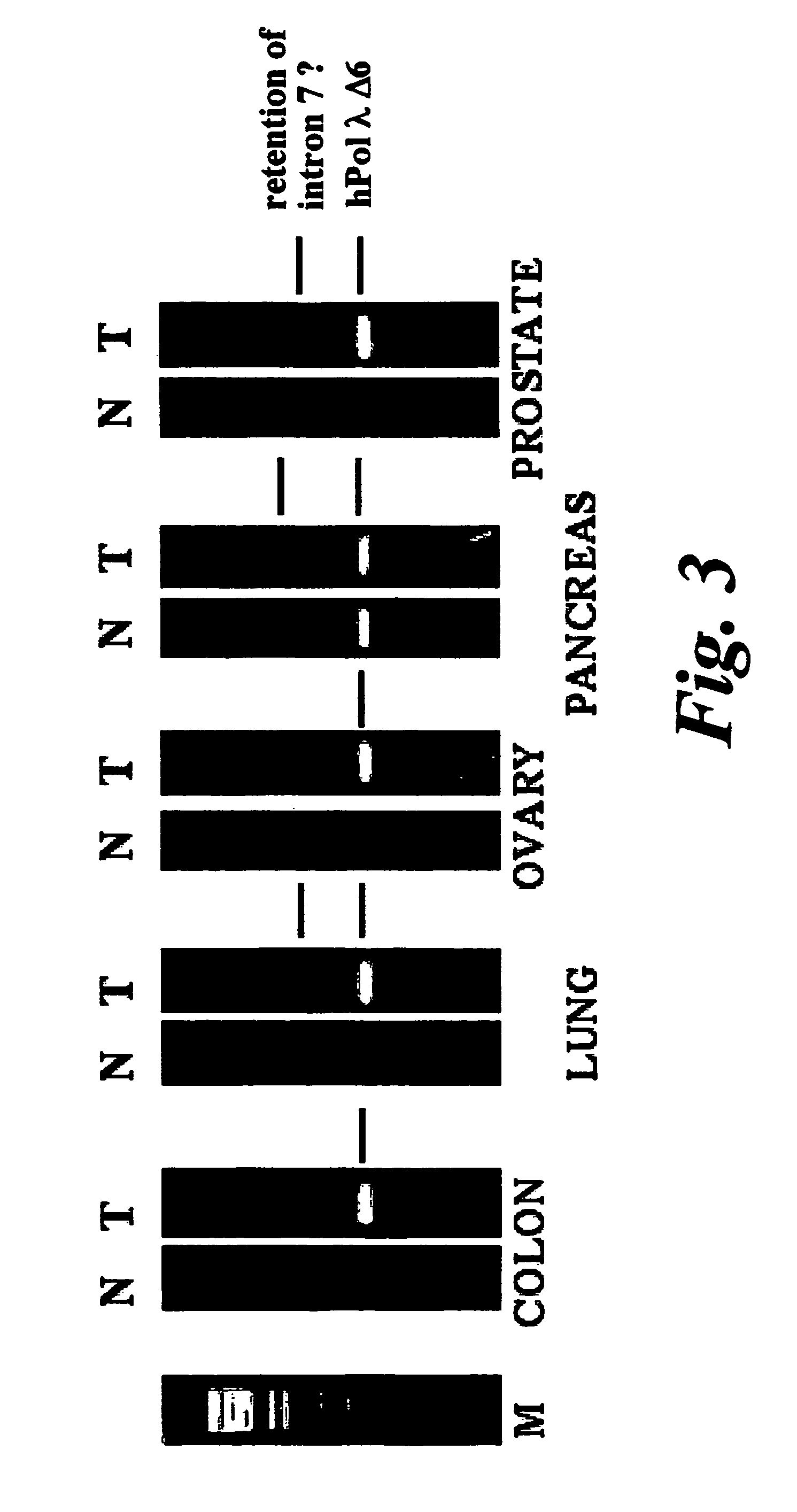DNA polymerase lambda and uses thereof
a technology of dna polymerase and lambda, which is applied in the field of identification and isolation of dna polymerase, can solve the problems of cellular transformation, premature aging and cell death, and somatic cells are much more vulnerable to dna damage, and achieve the effect of increasing the mutation frequency of the genom
- Summary
- Abstract
- Description
- Claims
- Application Information
AI Technical Summary
Benefits of technology
Problems solved by technology
Method used
Image
Examples
example 1
Cloning of the cDNA Corresponding to Human Pol λ
[0176]Cloning of the human POLL gene was initiated by the identification, in the public database dbEST / GeneBank, of a collection of ESTs that showed a high similarity with the cDNA sequence of the mouse POLL gene, previously obtained in our laboratory. These ESTs have the following identification numbers: AA742404, AA922738, AI091150, AA989195, W69567, AI123218, AI199486, AA576526, W69888, T81701 y H11886. All of them corresponded to the 3′-untranslated region, with the exception of the EST H11886, that seemed to contain part of the coding region of Pol λ. Starting with total cDNA obtained from human placenta, the cDNA corresponding to Pol λ was obtained as a series of overlapping fragments (FIG. 1) by PCR amplification. The first fragment (a136-20, FIG. 1) was obtained by specific PCR using primers derived form the ESTs described above. This fragment overlapped with the sequence of the EST H11886, and with the collection of ESTs corre...
example 2
PCR Analysis of Pol λ Variants in cDNA from Different Origin, Normal and Tumoral
[0178]To estimate the expression of the splicing variants hPOLLdelta6 and hPOLLdelta (6+7) in different tissues we developed assays to detect these variants at the cDNA level. The assay relies on the use of specific primers that allow to amplify cDNA fragments corresponding to each particular variant of Pol λ. As specific primers, able to distinguish among the different variants, splicing-specific sense primers were used, whereas a common antisense primer was used in all cases.
[0179]Antisense primer for both variants, named 2B2, corresponding to a common region located at exon 9: 2B2 5′-GGAGCGGTTGAAGTGTGC-3′ (SEQ ID NO: 45),
[0180]Sense primer, specific for the variant hPOLLdelta6, named 2B3, was designed in such a way that its first 11 5′-nucleotides correspond to the end of exon 5, whereas the rest of the primer correspond to the initial sequences of exon 7: 2B3 5′-CCTCGTACCAGGGCTTCC-3′ (SEQ ID NO: 46),...
example 3
Expression and Purification of Mouse Pol λ and Generation of Specific Antibodies
[0183]The cDNA region coding for Pol λ was PCR-amplified from the plasmid provided by the LLNL, using primers designed for a further cloning into sites EcoRI and NdeI of vector pT7, or into site EcoRI and BamHI of the expression plasmid pRSET-A (Invitrogen). In the latter case, a 6× Histidine tag is added at the N-terminus of the recombinant protein.
[0184]For transformation, the E. coli strain TOP10F′ was used. After checking all constructs by sequencing, transformation was carried out in the E. coli strain BL21 (DE3) pLysS, that harbours the T7 RNA polymerase gene under control of the lacUV5 promoter, inducible by IPTG. Induction of Pol λ expression was carried out at 30, 32 and 37° C., at an optical density of 0.6 (A600). IPTG (Sigma), at a concentration of 0.5 mM, was added. When indicated, Rifampicine (Sigma) was added 20 min after induction, at a concentration of 120 μg / ml. The optimal time of induc...
PUM
| Property | Measurement | Unit |
|---|---|---|
| temperature | aaaaa | aaaaa |
| pH | aaaaa | aaaaa |
| optical density | aaaaa | aaaaa |
Abstract
Description
Claims
Application Information
 Login to View More
Login to View More - R&D
- Intellectual Property
- Life Sciences
- Materials
- Tech Scout
- Unparalleled Data Quality
- Higher Quality Content
- 60% Fewer Hallucinations
Browse by: Latest US Patents, China's latest patents, Technical Efficacy Thesaurus, Application Domain, Technology Topic, Popular Technical Reports.
© 2025 PatSnap. All rights reserved.Legal|Privacy policy|Modern Slavery Act Transparency Statement|Sitemap|About US| Contact US: help@patsnap.com



